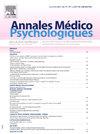时间视角下的倦怠阶段:叙事回顾
IF 0.5
4区 医学
Q4 PSYCHIATRY
引用次数: 0
摘要
由于职业倦怠的病例越来越多,预防和管理职业倦怠已成为主要关注的问题,强调了进一步研究以更好地描述这一现象的重要性。为了提供一种植根于工人经验的当代理解,本文引入了一种定性的方法来研究作为一个时间过程的倦怠体验。一些作者强调倦怠是一种状态,而另一些人则认为它是一个单独整合症状的过程,或者将其与工作环境的变化联系起来。本文从症状学和专业背景的角度,对相关文献进行了叙述性回顾,以调查职业倦怠的演变。参考书目数据库Medline (Ovid)和Psycinfo (Ovid),以及谷歌Scholar。定义了纳入和排除标准,以选择相关研究,包括主题相关性、成人人口、定性或描述性方法,同时排除缺乏全文可用性和不相关上下文的论文。进行了叙述性分析,包括对所选研究的方法、发现和局限性进行彻底检查。对结果进行综合和分类,以发现有关倦怠时间进展的共同主题。本研究确定了描述这一时间过程的四个阶段:高工作理想的投入和热情(阶段0),理想的削弱(阶段1),保护性退缩(阶段2)和确认倦怠(阶段3)。在阶段0,个人完全投入到他们的工作中,被理想主义的热情所驱动。他们在任务上投入了大量精力,认为工作是个人成就的主要来源。在这个阶段,精疲力竭的迹象很少见。在第一阶段,职业理想开始出现疲软的迹象。工作障碍、压力因素和冲突事件开始削弱最初的热情。尽管努力到精疲力竭,个人仍然面临着阻碍他们进步和职业实现的障碍,导致停滞和怀疑的感觉。在第二阶段,出现保护性戒断。曾经是工作满足感的源泉,现在却被视为一种威胁。个人发展出保护自己免受有害环境的策略,并开始对组织价值观采取越来越多的愤世嫉俗态度。与工作相关的问题也开始影响他们的个人生活。最后,在第三阶段,倦怠被确认。一份令人满意的工作的理想已经完全消失,个人发现自己无法维持正常的功能。倦怠通常由重大事件引发,表现为强烈的情绪和身体痛苦,可能导致病假和抑郁风险增加。人们开始怀疑他们的身份和个人价值,这标志着人们开始意识到并重新评估他们与工作的关系。该研究提供了一个模型,概述了从积极的工作投入情况到工人无法维持的痛苦状态的演变的临床框架,旨在促进理论与实践之间的转化,同时考虑到专业背景和症状学的演变。这种模式也引发了对预防的思考。一级预防指第0阶段,二级预防指第1和第2阶段,三级预防指第3阶段。因此,从业者可以更早地使用该模型来评估导致职业倦怠的环境和个人因素,提高对职业倦怠早期迹象的认识,或者根据员工的经历和痛苦的演变制定个性化的随访计划。本文章由计算机程序翻译,如有差异,请以英文原文为准。
Les stades du burnout selon une perspective temporelle : revue narrative
Due to the increasing number of burnout cases, prevention and management of burnout have become major concerns, underscoring the importance of further research to better delineate this phenomenon. To provide a contemporary understanding rooted in the experiences of workers, this article introduces a qualitative approach to the experience of burnout as a temporal process. Some authors emphasize burnout as a state, while others identify it as a process integrating symptomatology alone or associating it with changes in the work context. According to a temporal perspective focused on both symptomatology and the professional context, a narrative review of the literature was conducted to investigate the evolution of burnout. The bibliographic databases Medline (Ovid) and Psycinfo (Ovid), as well as Google Scholar, were consulted. Inclusion and exclusion criteria were defined to select relevant studies, including thematic relevance, adult population, qualitative or descriptive methodology while excluding papers lacking full-text availability and irrelevant contexts. A narrative analysis was conducted, involving a thorough examination of the methodologies, findings, and limitations of the chosen studies. Results were synthesized and classified to discern common themes concerning the temporal progression of burnout. This research identified four stages that depict this temporal process: engagement and enthusiasm with a high job ideal (stage 0), weakening of the ideal (stage 1), protective withdrawal (stage 2) and confirmed burnout (stage 3). At stage 0, individuals are fully engaged in their work, driven by idealistic enthusiasm. They invest a lot of energy in their tasks, considering work as a major source of personal accomplishment. At this stage, signs of burnout are rare. In stage 1, professional ideal begins to show signs of weakness. Work hindrance stressors and conflicting events start to diminish initial enthusiasm. Despite efforts exerted to exhaustion, individuals are confronted with obstacles that question their progress and professional fulfillment, resulting in a feeling of stagnation and doubt. At stage 2, a protective withdrawal occurs. What was once a source of work satisfaction is now perceived as a threat. Individuals develop strategies to protect themselves from harmful situations and begin to adopt an increasing cynicism towards organizational values. Work-related issues also start to impact their personal lives. Finally, in stage 3, burnout is confirmed. The ideal of a fulfilling job has completely disappeared, and individuals find themselves unable to maintain their usual functioning. Often triggered by a critical event, burnout manifests as intense emotional and physical distress, potentially leading to sick leave and an increased risk of depression. Doubts arise about their identity and personal worth, marking the beginning of an awareness and a reassessment of their relationship with work. Without being prescriptive or exhaustive, the study offers a model outlining a clinical framework for the evolution from a positive work engagement situation to an untenable suffering state for the worker, aiming to facilitate the translation between theory and practice while considering the evolution of the professional context and symptomatology. This model also prompts reflection on prevention. Primary prevention is referred to the stage 0, secondary prevention at stages 1 and 2, and tertiary prevention for stage 3. Practitioners can thus use this model earlier to assess environmental and individual factors contributing to burnout, raise awareness of early signs of burnout, or plan personalized follow-up based on the worker's journey and the evolution of their suffering.
求助全文
通过发布文献求助,成功后即可免费获取论文全文。
去求助
来源期刊

Annales medico-psychologiques
医学-精神病学
CiteScore
1.30
自引率
33.30%
发文量
196
审稿时长
4-8 weeks
期刊介绍:
The Annales Médico-Psychologiques is a peer-reviewed medical journal covering the field of psychiatry. Articles are published in French or in English. The journal was established in 1843 and is published by Elsevier on behalf of the Société Médico-Psychologique.
The journal publishes 10 times a year original articles covering biological, genetic, psychological, forensic and cultural issues relevant to the diagnosis and treatment of mental illness, as well as peer reviewed articles that have been presented and discussed during meetings of the Société Médico-Psychologique.To report on the major currents of thought of contemporary psychiatry, and to publish clinical and biological research of international standard, these are the aims of the Annales Médico-Psychologiques.
 求助内容:
求助内容: 应助结果提醒方式:
应助结果提醒方式:


